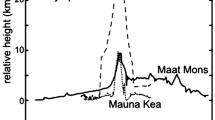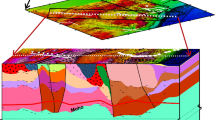Abstract
Hekla is the most active silicic volcano in Iceland, with 18 subplinian–Plinian eruptions since AD 1104. In the period 1970 to 2000, the frequency of such eruptions increased to once every decade. Hekla is currently inflated to above the levels observed prior to the most recent eruptions in 1991 and 2000. The next eruption could pose a hazard to air traffic between North America and Europe because explosive eruptions of Hekla, independent of size, typically start with a subplinian or Plinian phase that produces a sustained ash plume. We present an overview of five of the largest historical Hekla eruptions (taking place in 1104, 1158, 1300, 1693, and 1766). These eruptions cover a compositional range of rhyolite to andesite, previously estimated Volcanic Explosivity Index (VEI) values of 4–5 and are characterised by contrasting wind dispersal (dispersal axes NW–NE). New isopach maps show both greater deposit thicknesses in the proximal region and wider dispersal than previously inferred, resulting in different volume estimates (minimal values ranging between 0.18 and 0.91 km3). New isopleth maps were also compiled and resulted in inferred plume heights of about 13–25 km. These changes in the estimated values of volume and mass eruption rates have large implications on the forecasting and impacts of future Hekla eruptions.






Similar content being viewed by others
References
Beckett FM, Witham CS, Hort MC, Stevenson JA, Bonadonna C, Millington SC (2015) Sensitivity of dispersion model forecasts of volcanic ash clouds to the physical characteristics of the particles. J Geophys Res-Atmos. doi:10.1002/2015JD023609
Biass S, Bagheri G, Aeberhard WH, Bonadonna C (2014a) TError: towards a better quantification of the uncertainty propagated during the characterization of tephra deposits. Statistics in Volcanology 1:1–27. doi:10.5038/2163-338X.1.2
Biass S, Scaini C, Bonadonna C, Folch A, Smith K, Höskuldsson A (2014b) A multi-scale risk assessment for tephra fallout and airborne concentration from multiple Icelandic volcanoes- part 1: hazard assessment. Nat Hazard Earth Sys 14:2265–2287. doi:10.5194/nhess-14-2265-2014
Bonadonna C, Costa A (2012) Estimating the volume of tephra deposits: a new simple strategy. Geology 40:415–418. doi:10.1130/G32769.1
Bonadonna C, Costa A (2013) Plume height, volume, and classification of explosive volcanic eruptions based on the Weibull function. B Volcanol 75:742. doi:10.1007/s00445-013-0742-1
Bonadonna C, Houghton BF (2005) Total grain-size distribution and volume of tephra-fall deposits. B Volcanol 67:441–456. doi:10.1007/s00445-004-0386-2
Bonadonna C, Phillips JC (2003) Sedimentation from strong volcanic plumes. J Geophys Res-Sol Ea 108:2340–2368. doi:10.1029/2002JB002034
Bonadonna C, Ernst GGJ, Sparks RSJ (1998) Thickness variations and volume estimates of tephra fall deposits: the importance of particle Reynolds number. J Volcanol Geoth Res 81:173–187. doi:10.1016/S0377-0273(98)00007-9
Bonadonna C, Folch A, Loughlin S, Puempel H (2012) Future developments in modelling and monitoring of volcanic ash clouds: outcomes from the first IAVCEI-WMO workshop on Ash Dispersal Forecast and Civil Aviation (Geneva, Switzerland, 18–20 October 2010), Short Scientific Communication, Bulletin of Volcanology (http://www.springerlink.com/content/h01x16460482134w/)
Bonadonna C, Biass S, Costa A (2015a) Physical characterization of explosive volcanic eruptions based on tephra deposits: propagation of uncertainties and sensitivity analysis. J Volcanol Geoth Res 296:80–100. doi:10.1016/j.jvolgeores.2015.03.009
Bonadonna C, Pistolesi M, Cioni R, Degruyter W, Elissondo M, Baumann V (2015b) Dynamics of wind-affected volcanic plumes: the example of the 2011 Cordón Caulle eruption, Chile. J Geophys Res-Sol Ea 120:2242–2261. doi:10.1002/2014JB011478
Burden RE, Chen L, Phillips JC (2013) A statistical method for determining the volume of volcanic fall deposits. B Volcanol 75:707. doi:10.1007/s00445-013-0707-4
Carey S, Sigurdsson H (1989) The intensity of plinian eruptions. B Volcanol 51:28–40. doi:10.1007/BF01086759
Carey S, Sparks RSJ (1986) Quantitative models for the fallout and dispersal of tephra from volcanic eruption columns. B Volcanol 48:109–125. doi:10.1007/BF01046546
Carey RJ, Houghton BF, Thordarson T (2009) Tephra dispersal and eruption dynamics of wet and dry phases of the 1875 eruption of Askja volcano, Iceland. B Volcanol 72:259–278. doi:10.1007/s00445-009-0317-3
Cioni R, Longo A, Macedonio G, Santacroce R, Sbrana A, Sulpizio R, Andronico D (2003) Assessing pyroclastic fall hazard through field data and numerical simulations: example from Vesuvius. J Geophys Res-Sol Ea 108:2063. doi:10.1029/2001JB000642
Cooke MC, Francis PN, Millington S, Saunders R, Witham C (2014) Detection of the Grímsvötn 2011 volcanic eruption plumes using infrared satellite measurements. Atmos Sci Lett 15:321–327. doi:10.1002/asl2.506
Degruyter W, Bonadonna C (2012) Improving on mass flow rate estimates of volcanic eruptions. Geophys Res Lett 39:L16308. doi:10.1029/2012GL052566
Dugmore AJ, Church MJ, Mairs K-A, McGovern TH, Perdikaris S, Vesteinsson O (2007) Abandoned farms, volcanic impacts, and woodland management: revisiting Þjórsárdalur, the “Pompeii of Iceland. Arctic Anthropol 44:1–11. doi:10.1353/arc.2011.0021
Fierstein J, Nathenson M (1992) Another look at the calculation of fallout tephra volumes. B Volcanol 54:156–167. doi:10.1007/BF00278005
Folch A, Sulpizio R (2010) Evaluating long-range volcanic ash hazard using supercomputing facilities: application to Somma-Vesuvius (Italy), and consequences for civil aviation over the Central Mediterranean area. B Volcanol 72:1039–1059. doi:10.1007/s00445-010-0386-3
Gronvold K, Larsen G, Einarsson P, Thorarinsson S, Saemundsson K (1983) The Hekla eruption 1980–1981. B Volcanol 46:349–363. doi:10.1007/BF02597770
Gudmundsson A, Oskarsson N, Gronvold K, Saemundsson K, Sigurdsson O, Stefansson R, Gislason SR, Einarsson P, Brandsdottir B, Larsen G, Johannesson H, Thordarson T (1992) The 1991 eruption of Hekla, Iceland. B Volcanol 54:238–246. doi:10.1007/BF00278391
Gudmundsson MT, Höskuldsson A, Larsen G, Thordarson T, Oladottir BA, Oddsson B, Gudnason J, Högnadottir T, Stevenson JA, Houghton BF, McGarvie D, Sigurdardottir GM (2012) The may 2011 eruption of Grímsvötn. Geophys Res Abstr 14:EGU2012–EG12119
Höskuldsson Á, Óskarsson N, Pedersen R, Grönvold K, Vogfjörd K, Ólafsdottir R (2007) The millennium eruption of Hekla in February 2000. B Volcanol 70:169–182. doi:10.1007/s00445-007-0128-3
Houghton BF, Swanson DA, Rausch J, Carey RJ, Fagents SA, Orr TR (2013) Pushing the Volcanic Explosivity Index to its limit and beyond: constraints from exceptionally weak explosive eruptions at Kilauea in 2008. Geology 41:627–630. doi:10.1130/G34146.1
Jenkins S, McAneney J, Magill C, Blong R (2012) Regional ash fall hazard II: Asia-Pacific modelling results and implications. B Volcanol 74:1713–1727. doi:10.1007/s00445-012-0628-7
Klawonn M, Houghton BF, Swanson DA, Fagents SA, Wessel P, Wolfe CJ (2014a) Constraining explosive volcanism: subjective choices during estimates of eruption magnitude. B Volcanol 76:793. doi:10.1007/s00445-013-0793-3
Klawonn M, Houghton BF, Swanson DA, Fagents SA, Wessel P, Wolfe CJ (2014b) From field data to volumes: constraining uncertainties in pyroclastic eruption parameters. B Volcanol 76:839. doi:10.1007/s00445-014-0839-1
Larsen G (1992) Gjóskulagid úr Heklugosinu 1158 (The tephra layer from the 1158 AD eruption of Hekla). Jardfrædafélag Islands, Vorrádstefna, Yfirlit og Ágrip. Geoscience Society of Iceland, Reykjavík, pp 25–27
Larsen G, Thorarinsson S (1977) H4 and other acid Hekla tephra layers. Jokull 27:28–46
Larsen G, Dugmore A, Newton A (1999) Geochemistry of historical-age silicic tephras in Iceland. The Holocene 9:463–471. doi:10.1191/095968399669624108
Le Pennec J-L, Ruiz GA, Ramón P, Palacios E, Mothes P, Yepes H (2012) Impact of tephra falls on Andean communities: the influences of eruption size and weather conditions during the 1999–2001 activity of Tungurahua volcano, Ecuador. J Volcanol Geoth Res 217–218:91–103. doi:10.1016/j.jvolgeores.2011.06.011
Mastin LG, Guffanti M, Ewert JE, Spiegel J (2009a) Preliminary spreadsheet of eruption source parameters for volcanoes of the world. U.S. Geological Survey Open-File Report 2009–1133, v. 1.2
Mastin LG, Guffanti M, Servranckx R, Webley P, Barsotti S, Dean K, Durant A, Ewert JW, Neri A, Rose WI, Schneider D, Siebert L, Stunder B, Swanson G, Tupper A, Volentik A, Waythomas CF (2009b) A multidisciplinary effort to assign realistic source parameters to models of volcanic ash-cloud transport and dispersion during eruptions. J Volcanol Geoth Res 186:10–21. doi:10.1016/j.jvolgeores.2009.01.008
Petersen GN, Bjornsson H, Arason P, von Löwis S (2012) Two weather radar time series of the altitude of the volcanic plume during the May 2011 eruption of Grímsvötn, Iceland. Earth System Science Data 4:121–127. doi:10.5194/essd-4-121-2012
Pyle DM (1989) The thickness, volume and grainsize of tephra fall deposits. B Volcanol 51:1–15. doi:10.1007/BF01086757
Pyle DM (1995) Assessment of the minimum volume of tephra fall deposits. J Volcanol Geoth Res 69:379–382. doi:10.1016/0377-0273(95)00038-0
Scaini C, Biass S, Galderisi A, Bonadonna C, Folch A, Smith K, Höskuldsson A (2014) A multi-scale risk assessment for tephra fallout and airborne concentration from multiple Icelandic volcanoes—part 2: vulnerability and impact. Nat Hazard Earth Sys 14:2289–2312. doi:10.5194/nhess-14-2289-2014
Sturkell E, Ágústsson K, Linde AT, Sacks SI, Einarsson P, Sigmundsson F, Geirsson H, Pedersen R, LaFemina PC, Ólafsson H (2013) New insights into volcanic activity from strain and other deformation data for the Hekla 2000 eruption. J Volcanol Geoth Res 256:78–86. doi:10.1016/j.jvolgeores.2013.02.001
Thorarinsson S (1954) The tephra-fall from Hekla on March 29, 1947. In: Einarsson T, Kjartansson G, Thorarinsson S (eds) The eruption of Hekla 1947–1948. Societas Scientiarum Islandica, Reykjavík, pp. 1–68
Thorarinsson S (1967) The eruptions of Hekla in historical times: a tephrochronological study. In: Einarsson T, Kjartansson G, Thorarinsson S (eds) The eruption of Hekla 1947–1948. Societas Scientiarum Islandica, Reykjavík, pp. 1–177
Thordarson T, Höskuldsson Á (2008) Postglacial volcanism in Iceland. Jokull 58:197–228
Thordarson T, Larsen G (2007) Volcanism in Iceland in historical time: volcano types, eruption styles and eruptive history. J Geodyn 43:118–152. doi:10.1016/j.jog.2006.09.005
Walker GL (1973) Explosive volcanic eruptions—a new classification scheme. Geol Rundsch 62:431–446. doi:10.1007/BF01840108
Wilson L, Walker GPL (1987) Explosive volcanic eruptions—VI. Ejecta dispersal in Plinian eruptions: the control of eruption conditions and atmospheric properties. Geophys J Roy Astr S 89:657–679. doi:10.1111/j.1365-246X.1987.tb05186.x
Acknowledgements
This research was funded by the National Science Foundation grant EAR12-20596. The authors are grateful to Wim Degruyter for developing a dedicated and simple script for the calculation of MER. Special thanks to Kristine Curran, Carolyn Parcheta, Samantha Weaver, Jonas Gudnason, William Moreland, Catherine Gallagher and Jodi Fox for assistance with field work. The manuscript was significantly enhanced by insightful reviews by M. Nathenson and an anonymous reviewer, and comments from D. Swanson, S. Fagents and editor J. Fierstein.
Author information
Authors and Affiliations
Corresponding author
Additional information
Editorial responsibility: J. Fierstein
Rights and permissions
About this article
Cite this article
Janebo, M.H., Thordarson, T., Houghton, B.F. et al. Dispersal of key subplinian–Plinian tephras from Hekla volcano, Iceland: implications for eruption source parameters . Bull Volcanol 78, 66 (2016). https://doi.org/10.1007/s00445-016-1059-7
Received:
Accepted:
Published:
DOI: https://doi.org/10.1007/s00445-016-1059-7




